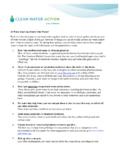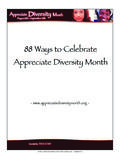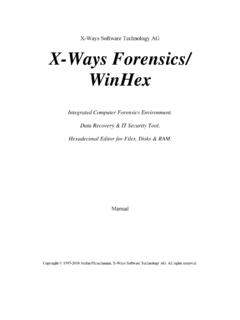Transcription of 10 Quick Ways to Analyze Children’s Books For Racism and ...
1 10 quick ways to analyze children s books For Racism and Sexism Both in school and out of school, young children are exposed to racist and sexist attitudes. These attitudes expressed repeatedly in Books and other media gradually distort children s perceptions until stereotypes and myths about minorities and women are accepted as reality. It is difficult for librarians or teachers to convince children to question society s attitudes; but if children can learn to detect Racism and sexism in Books , they can transfer that skill to other areas. The following ten guidelines can be used by teachers, librarians, and other educators to evaluate children s Books and to help students detect Racism and sexism in the Books they read. 1. Check the Illustrations Look for stereotypes. A stereotype, which usually has derogatory implications, is an oversimplified generalization about a particular group, race, or sex. Some infamous (overt) stereotypes of blacks are the happy-go-lucky, watermelon-eating Sambo and the fat, eye-rolling mammy; of Chicanos, the sombrero-wearing peon or fiesta-loving, macho bandito; of Asian Americans, the inscrutable, slant-eyed oriental; of American Indians, the naked savage or primitive brave and his squaw; of Puerto Ricans, the switchblade-toting teenage gang member; and of women, the domesticated mother, the demure little girl, or the wicked stepmother.
2 While you may not always find stereotypes in the blatant forms described, look for descriptions, depictions, or labels that tend to demean, stereotype, or patronize characters because of their race or sex. Look for tokenism. If racial minority characters appear in the illustrations, do they look like white people except for being tinted or colored? Do all minorities look stereotypically alike, or are they depicted as individuals with distinctive features? Look for active doers. Do the illustrations depict minorities in subservient and passive roles or in leadership and action roles? Are males the active doers and females the inactive observers? 2. Check the Story Line Publishers are making an effort not to include adverse reflections or inappropriate portrayals of minority characters in stories; however, racist and sexist attitudes still find expression in less obvious ways . Examples of some subtle (covert) forms of bias include the following: Standard for success: Does it take white behavior standards for a minority person to get ahead?
3 Is making it in the dominant white society projected as the only ideal? To gain acceptance and approval, do persons of color have to exhibit extraordinary qualities, excel in sports, get A s, and so forth? In friendships between white and nonwhite children , is it the child of color who does most of the understanding and forgiving? Resolution of problems: How are problems presented, conceived, and resolved? Are minority people considered to be the problem? Are the oppressions faced by minorities and women represented as related to social injustice? Are the reasons for poverty and oppressions explained, or are poverty and oppression accepted as inevitable? Does the story line encourage passive acceptance or active resistance? Is a particular problem faced by a racial minority person or a female resolved through the benevolent intervention of a white person or a male? Role of women: Are the achievements of girls and women based on their own initiative and intelligence, or are their achievements due to their good looks or relationships with boys?
4 Are sex roles incidental or critical to characterization and plot? Could the same story be told if the sex roles were reversed? 10 quick ways to analyze children s books for Racism and Sexism Page 2 3. Look at the Life-Styles Are minority persons and their settings depicted in ways that contrast unfavorably with the unstated norm of white middle-class suburbia? If the minority group in question is depicted as different, are negative value judgments implied? Are minorities depicted exclusively in ghettos, barrios, or migrant camps? If the illustrations and text depict other cultures, do they go beyond oversimplifications and offer genuine insights into other life-styles? Look for inaccuracies and inappropriateness in the depictions of other cultures. Watch for instances of the quaint-natives-in costume syndrome, which is noticeable in areas such as clothing, customs, behaviors, and personality traits. 4. Weigh the Relationships Among People Do white people in the story possess the power, take the leadership, and make the important decisions?
5 Do racial minorities and females of all races primarily function in supporting roles? How are family relationships depicted? In black families is the mother always dominant? In Hispanic families are there always many children ? If the family is separated, are social conditions unemployment and poverty, for example cited as reasons for the separation? Are both sexes portrayed in nurturing roles with their families? 5. Note the Heroes For many years Books showed only safe minority heroes those who avoided serious conflict with the white establishment. Today, minority groups insist on the right to define their own heroes (of both sexes) based on their own concepts and struggle for justice. When minority heroes do appear, are they admired for the same qualities that have made white heroes famous or because what they have done has benefited white people? Ask this question: Whose interest is a particular hero serving? 6. Consider the Effects on a Child s Self-Image Are norms established that limit any child s aspiration and self-concept?
6 What effect can it have on black children to be continually bombarded with images of the color white as the ultimate in beauty, cleanliness, and virtue and the color black as evil, dirty, and menacing? Does the book counteract or reinforce this positive association with the color white and negative association with the color black? What happens to a girl s self-image when she reads that boys perform all brave and important deeds? What is the effect on a girl s self-esteem if she is not fair of skin and slim of body? In a particular story is there one or more persons with whom a minority child can readily and positively identify? 7. Check Out the Author s Perspective No author can be entirely objective. All authors write from a cultural as well as personal context. In the past, children s Books were written by members of the middle class. Consequently, a single ethnocentric perspective has dominated children 's literature in the United States. Read carefully any book in question to determine whether the author s perspective substantially weakens or strengthens the value of his or her written work.
7 Is the perspective patriarchal or feminist? Is it solely Eurocentric, or are minority cultural perspectives respected? 10 quick ways to analyze children s books for Racism and Sexism Page 3 8. Watch for Loaded Words A word is loaded when it has insulting over-tones. Examples of local adjectives (usually racist) are savage, primitive, conniving, lazy, superstitious, treacherous, wily, crafty, inscrutable, docile, and backward. Look for sexist language and adjectives that exclude or ridicule women. Look for use of the male pronoun to refer to both males and females. While the generic use of the word man was accepted in the past, its use today is outmoded. The following examples illustrate how sexist language can be avoided: substitute the word ancestors for forefathers; chairperson for chairman; community for brotherhood; firefighters for firemen; manufactured for manmade, and the human family for the family of man. 9. Look at the Copyright Date With rare exceptions nonsexist Books were not published before 1973.
8 However, in the early 1970s children s Books began to reflect the realities of a multiracial society. This new direction resulted from the emergence of minority authors who wrote about their own experiences. Unfortunately, this trend was reversed in the late 1970s, and publishers cut back on such Books . Therefore, although the copyright date can be a clue as to how likely the book is to be overtly racist or sexist, a recent copyright date is no guarantee of a book s relevance or sensitivity. The copyright date indicates only the year the book was published. It usually takes about two years from the time a manuscript is submitted to the publisher to the time it is printed. This time lag meant little in the past; but today, publishers attempt to publish relevant children s Books , and this time lag is significant. 10. Consider Literacy, Historical, and Cultural Perspectives Classical or contemporary literature, including folktales and stories having a particular historical or cultural perspective, should be judged in the context of high-quality literary works.
9 In many cases it may be inappropriate to evaluate classical or contemporary literature according to the guidelines contained in this brochure. However, when analyzing such literary works, remember that although a particular attitude toward women or a minority group was prevalent during a certain period in history, that attitude is in the process of changing. Adapted from the original brochure, which was published by the Council on Interracial Books for children by the CALIFORNIA STATE DEPARTMENT OF EDUCATION Bill Honig, Superintendent of Public Instruction Sacramento, 1998 This brochure, adapted with permission for the Council on Interracial Books for children , 1841 Broadway, New York, NY 10023, is provided by Project SEE (Sex Equity in Education), California State Department of Education, Box 944272, Sacramento, CA 94244-2720; telephone 916-322-7388. A related filmstrip, Identifying Sexism and Racism in children s Books , is also available on loan from Project SEE. In addition, detailed criteria for evaluating children s Books is contained in Standards for Evaluation of Instructional Materials with Respect to Social Content, which is available for $ , plus sales tax for California residents from Publications Sales, California State Department of Education, Box 271, Sacramento, CA 95802-0271.
10 EH:drp 9/01








